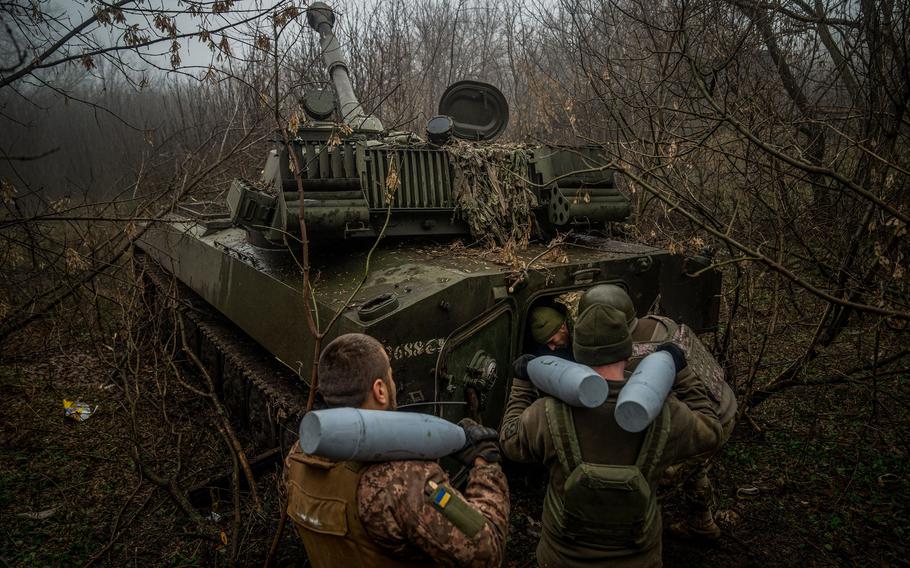Europe
EU to propose three-track plan to boost Ukraine ammo supplies
Bloomberg News March 2, 2023

Ukrainian artillerymen from the 24th brigade load an ammunition inside of a 2S1 Gvozdika self-propelled howitzer at a position along the front line in the vicinity of Bakhmut, Donetsk region, on Dec. 10, 2022, amid the Russian invasion of Ukraine. (Ihor Tkachov/AFP)
The European Union is set to propose a three-track plan to provide Ukraine with much-needed ammunition in response to some member states' calls to ramp up the continent's production capacity, but the amount of funding remains unclear.
The proposal calls for the immediate transfers of ammunition, particularly 155mm artillery rounds from existing stocks or pending orders, as well as using a joint procurement framework to aggregate orders to European industry, according to a document obtained by Bloomberg. The paper also envisions ramping up Europe's industrial capacity to meet the current and future demand.
"All three elements are crucial to sustain our support for Ukraine moving forward," the paper says. "All three tracks need to be pursued in parallel and as a matter of urgency."
The plan, which echoes a letter the bloc's top diplomat Josep Borrell sent to E.U. defense ministers last week, makes scarce mention of precise dollar figures or readily available sources of funding to immediately boost capacity.
Sending ammo to Ukraine has become a top priority for European nations and the U.S., according to people familiar with the matter. The issue is expected to be high on the agenda when President Joe Biden meets German Chancellor Olaf Scholz later this week, the people said. The U.S. has been urging its European allies to move as quickly as possibly, the people added.
E.U. defense ministers will discuss the proposals at a meeting in Sweden next week, with the aim of sealing an agreement by the time leaders meet later this month in Brussels.
Estonia, which first raised the issue earlier this year, has said that the E.U. nations should invest around $4.3 billion to jointly procure the 1 million rounds of ammunition that Ukraine says it needs this year, Bloomberg previously reported.
Russia is currently firing the same amount of ammunition in a single day in Ukraine that Europe can produce in a month, the Baltic nation pointed out.
The E.U. document says that Borrell will propose a €1 billion package to reimburse member states that send Ukraine ammo from their own stocks at a favorable rate of up to 90%.
"Like-minded partners could be invited to support this effort through voluntary financial contributions," the paper says. Some of the document's contents were first reported by Germany's Spiegel.
The second track of the E.U. plan would see Ukraine's requirements addressed through a soon-to-be-launched seven-year procurement project led by the European Defense Agency to cover member state needs, ranging from small arms ammo up to 155mm shells.
"It is proposed to use this framework contract to also address current and future Ukrainian needs, on top of the ones expressed by member states," the paper says. Contracts could be tentatively concluded "between end-April and end-May," it adds.
The European Peace Facility, the mechanism the E.U. is currently using to support weapons deliveries to Ukraine by reimbursing what member states send Kyiv, could also be used as an option to directly procure ammunition for Ukraine or for member states to procure the ammo and then deliver it, the paper says. In both cases, governments would need to decide how to fund the initiatives and likely lift the EPF's budget ceiling.
An E.U. diplomat said the EPF options were preferable as member states' contributions were clearly defined and that path would be quicker and smoother. The amount of funding should reflect Ukraine's requirements and was needed as soon as possible, the diplomat said. Without extra liquidity this year, member states cannot procure what Kyiv needs before 2024 and the war might be over by then, the diplomat added.
E.U. member states in December agreed to raise the €5.7 billion EPF fund's ceiling by €2 billion, with a possibility to add several more billion euros at a later stage. A total of €3.6 billion from that fund has already been pledged to support Ukraine's military, largely through reimbursements for allies' weapons deliveries.
Finally, the E.U. plans to propose various measures to ramp up production in the longer term and overcome some of the challenges the industry faces to enable member states to replenish their stocks. Those include:
— mapping E.U. production capacities throughout the supply chain
— identifying and helping to remove production bottlenecks in the E.U.;
— measures to promote the efficient re-organization of supply chains and production lines;
— facilitating efficient procurement procedures for timely delivery of the defense products and raw materials;
— facilitating the collaboration of relevant companies in a joint industry effort to ensure availability and supply;
— assessing and addressing obstacles to access to market financing for expanding, ramping-up or repurposing of industrial capacities toward the urgent production of ammunition, including the role of national promotional banks and the European Investment Bank;
— speeding up permitting procedures.
Bloomberg News writers Michael Nienaber and Arne Delfs contributed to this story.
©2023 Bloomberg L.P. Visit bloomberg.com.
Distributed by Tribune Content Agency, LLC.